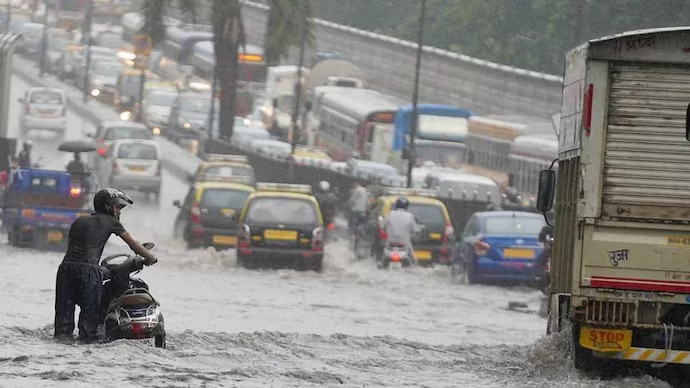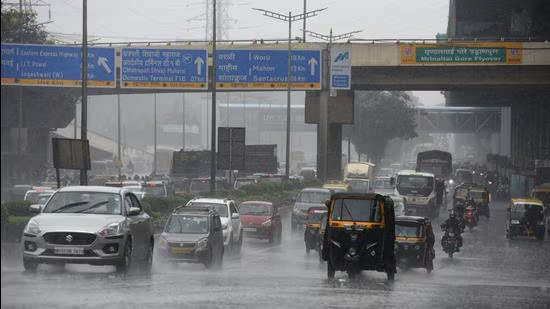

Monsoon-Proofing Mumbai’s Roads: A Step Towards a Resilient City, India’s financial capital, is undertaking a massive infrastructure project to monsoon-proof its roads. With an investment of nearly $700 million, the city aims to lay over 400 km of durable concrete roads to withstand heavy rains and prevent potholes. While the initiative promises long-term benefits, it has also led to significant disruptions in traffic and daily life. This blog explores the key aspects of the project, its challenges, and its potential impact on Mumbai’s future.
1. The Need for Monsoon-Proof Roads
Monsoon-Proofing Mumbai’s Roads: A Step Towards a Resilient City, Mumbai experiences heavy rainfall every year during the monsoon season, leading to severe waterlogging and pothole-ridden roads. The city’s existing asphalt roads often fail to withstand the continuous downpour, resulting in cracks and dangerous potholes that cause accidents and disrupt daily commutes. This has long been a concern for both citizens and authorities, prompting the need for a durable solution.
The decision to transition to concrete Monsoon-Proofing Mumbai’s Roads: A Step Towards a Resilient City is a strategic move aimed at enhancing road longevity and reducing maintenance costs. Concrete is more resilient to water damage compared to asphalt, making it an ideal choice for a city that faces relentless monsoon challenges. While the initial cost of concrete roads is higher, they require less frequent repairs, ultimately making them a cost-effective solution in the long run.
2. The Scale and Scope of the Project
The Brihanmumbai Municipal Corporation (BMC) has launched an ambitious plan to pave 400 km of roads with concrete by 2026 to Monsoon-Proofing Mumbai’s Roads: A Step Towards a Resilient City. This includes key arterial roads, highways, and internal roads that experience heavy traffic. The project also involves improving drainage systems to ensure proper water flow and prevent water accumulation.
While this is not the first time Monsoon-Proofing Mumbai’s Roads: A Step Towards a Resilient City has undertaken road improvement projects, the current initiative is one of the largest in scale. The authorities have prioritized high-traffic areas to minimize disruptions in future monsoons. However, the execution of such a large-scale project has posed logistical challenges, leading to temporary inconveniences for commuters and businesses.

3. Public Reaction: Frustration vs. Hope
Monsoon-Proofing Mumbai’s Roads: A Step Towards a Resilient City, While the long-term benefits of concrete roads are undeniable, the ongoing construction has created significant traffic congestion across the city. Multiple roads are being worked on simultaneously, leading to detours, bottlenecks, and increased travel time. Citizens have expressed frustration over poor planning, inadequate alternative routes, and the slow pace of construction in some areas.
Despite these inconveniences, many Mumbaikars remain hopeful that the project will bring much-needed relief in the coming years. Past experiences with concrete roads in select areas have shown positive results, reinforcing confidence in the initiative. Once completed, the new roads are expected to drastically reduce the number of potholes and improve commuting conditions, making Mumbai a more resilient city during the monsoon season.
4. Challenges in Implementation
One of the biggest challenges in implementing this project is managing construction while ensuring smooth traffic flow. Since Mumbai is a densely populated city with limited space, finding ways to carry out large-scale roadwork without causing chaos has been difficult to Monsoon-Proofing Mumbai’s Roads: A Step Towards a Resilient City.
Additionally, the project requires extensive coordination between different departments, including road construction teams, drainage system engineers, and traffic management authorities. Delays in one aspect of the project can create a ripple effect, leading to further setbacks. The authorities must ensure efficient execution to prevent unnecessary prolongation of road closures.
5. Environmental and Economic Considerations
Concrete roads have several advantages, but they also raise concerns about environmental impact. Unlike asphalt, concrete production involves high energy consumption and carbon emissions. Monsoon-Proofing Mumbai’s Roads: A Step Towards a Resilient City However, proponents argue that since concrete roads last longer and require fewer repairs, their overall environmental footprint is lower in the long term.
From an economic perspective, while the initial investment is high, the reduced maintenance costs will save the city a significant amount of money in the future. Businesses and daily commuters stand to benefit from fewer road closures and better road quality, ultimately boosting productivity and economic efficiency.
6. The Role of Technology in Road Construction
Advancements in road construction technology are playing a crucial role in ensuring the success of this project. Engineers are using high-performance concrete mixtures that enhance durability and reduce construction time. Additionally, Monsoon-Proofing Mumbai’s Roads: A Step Towards a Resilient City, digital monitoring systems are being deployed to track project progress and detect structural weaknesses early.
Another key innovation is the use of pre-cast concrete slabs, which can be quickly assembled on-site, reducing the time needed for construction. These technological interventions are helping authorities optimize the project and minimize disruptions as much as possible.
7. The Future of Mumbai’s Roads
Once completed, Mumbai’s new concrete roads will set a precedent for other cities facing similar monsoon-related challenges. The project could serve as a model for urban infrastructure planning, demonstrating the importance of long-term investments in road quality.
Additionally, Monsoon-Proofing Mumbai’s Roads: A Step Towards a Resilient City, While challenges remain, the vision of a pothole-free Mumbai is now closer to reality than ever before. With effective planning, citizen cooperation, and continued technological advancements, Mumbai could soon transform into a city where monsoons no longer mean chaos on the roads but a seamless urban experience. The success of this project will not only redefine Mumbai’s road network but also improve the overall quality of life for millions of its residents.
Buy Domin and Hsoting with our trusted websites
https://www.hostinger.in/
https://www.bluehost.com/
Visit our website
https://spotself.com/




Leave a Reply